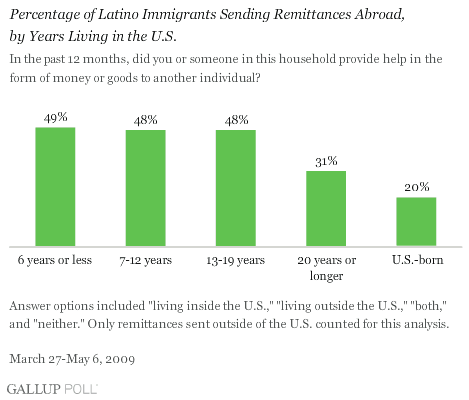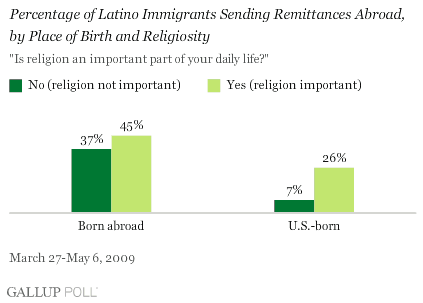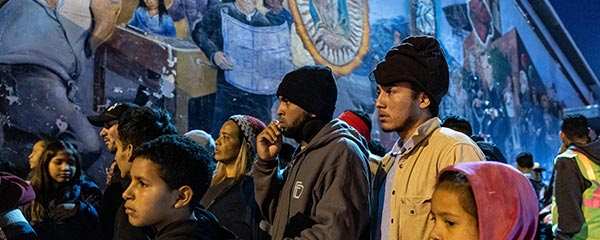WASHINGTON, D.C. -- About half (48% to 49%) of Latino immigrants who have come to the U.S. in the last 19 years say that in the last 12 months, they have sent money to someone living abroad -- a number that holds remarkably steady whether they have lived in the U.S. less than 6 years or between 13 and 19 years. A Gallup survey of more than 1,000 U.S. Latinos finds that the percentage of Latino immigrants who send money (i.e., remittances) abroad is steady for those who have been living in the U.S. less than 20 years, and drops among those who have been in the country for at least 20 years. The rate of sending remittances drops off further among Latinos born in the U.S. -- to 20%.

The findings are evidence of the close ties many Latinos retain with their home countries.
"U.S.-born Latinos who say religion plays an important role in their daily lives are more than three times as likely to send remittances (26%) as are U.S.-born Latinos who say religion does not play such a role (7%). "
Even among Latinos who immigrated to the U.S. at least 20 years ago, almost a third (31%) still report sending remittances. The consistency of these relationships is crucial to millions of Latin Americans who depend on remittances from the U.S. to cover basic living expenses -- or to be able, for example, to take the financial risk of starting a new business. According to the World Bank, Mexico received more than $25 billion in remittances in 2007; a great deal of this money came from the U.S. No other Latin American country receives as much in remittances as Mexico does. However, many countries rely much more heavily on what they do receive. In both Honduras and Guyana, remittances accounted for more than 20% of GDP in 2007.
Role of Religion in Sending Remittances
Analysis of these findings by religiosity reveals that, for Latinos born in the U.S., the likelihood of sending remittances is strongly related to whether religion is important in their daily lives. U.S.-born Latinos who say religion plays an important role in their daily lives are more than three times as likely to send remittances (26%) as are U.S.-born Latinos who say religion does not play such a role (7%). Among Latinos born abroad, religiosity is less strongly associated with the tendency to send remittances (45% versus 37%).

These findings, especially those for Latinos born in the U.S., are consistent with other Gallup findings regarding the interplay between religion and behavior.
Bottom Line
These findings demonstrate the power of social connections to drive important and enduring economic processes. The finding that so many Latinos report sending remittances is particularly impressive given the fact that Gallup surveyed these respondents in the spring of 2009, when the current economic crisis was in full bloom. People who continue to send remittances home after living abroad for many years are honoring a commitment that makes sense socially but seems to defy "rational" economic self-interest. Religion may play a role in reinforcing the perceived importance of those commitments and strengthening those ties over the long term. From an economic perspective, remittances cannot be understood without accounting for the "irrational" social influences of relationships and religion.
Survey Methods
Results are based on telephone interviews conducted with 1,003 U.S. Latinos, aged 18 and older, between March 27 and May 6, 2009. This includes 545 Latinos who report having been born abroad and 453 who report having been born in the U.S. For analyses of immigrant groups based on years living in the U.S., sample sizes range from 106 to 184. Sample sizes for the religiosity analyses according to nativity range from 115 to 366. The maximum 95% margin of error for the smallest single group, incorporating a design effect of 1.82, is ±13 percentage points. Margins of error for the larger samples of 453 and 545 are both ±6 percentage points.
Interviews are conducted on land-line telephones (for respondents with a land-line telephone) and cellular phones (for respondents who are cell-phone only).
In addition to sampling error, question wording and practical difficulties in conducting surveys can introduce error or bias into the findings of public opinion polls.
